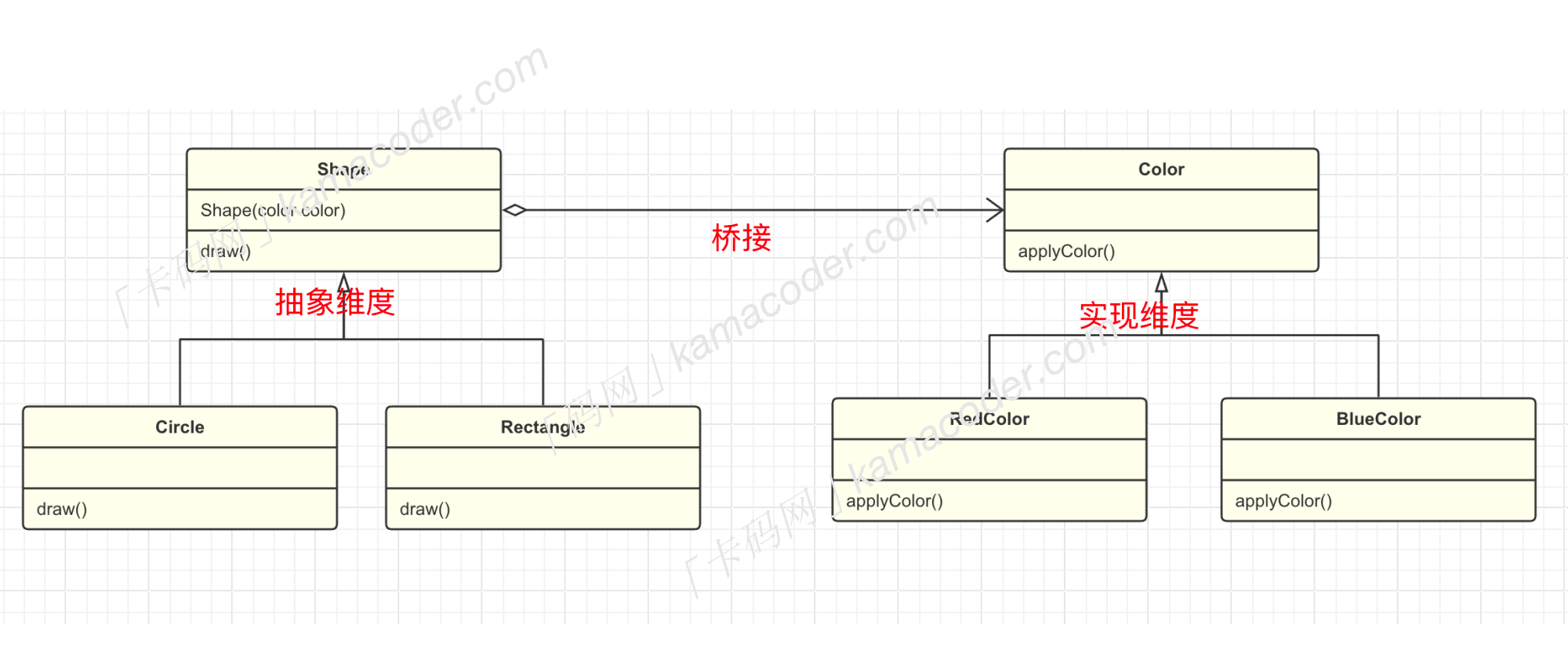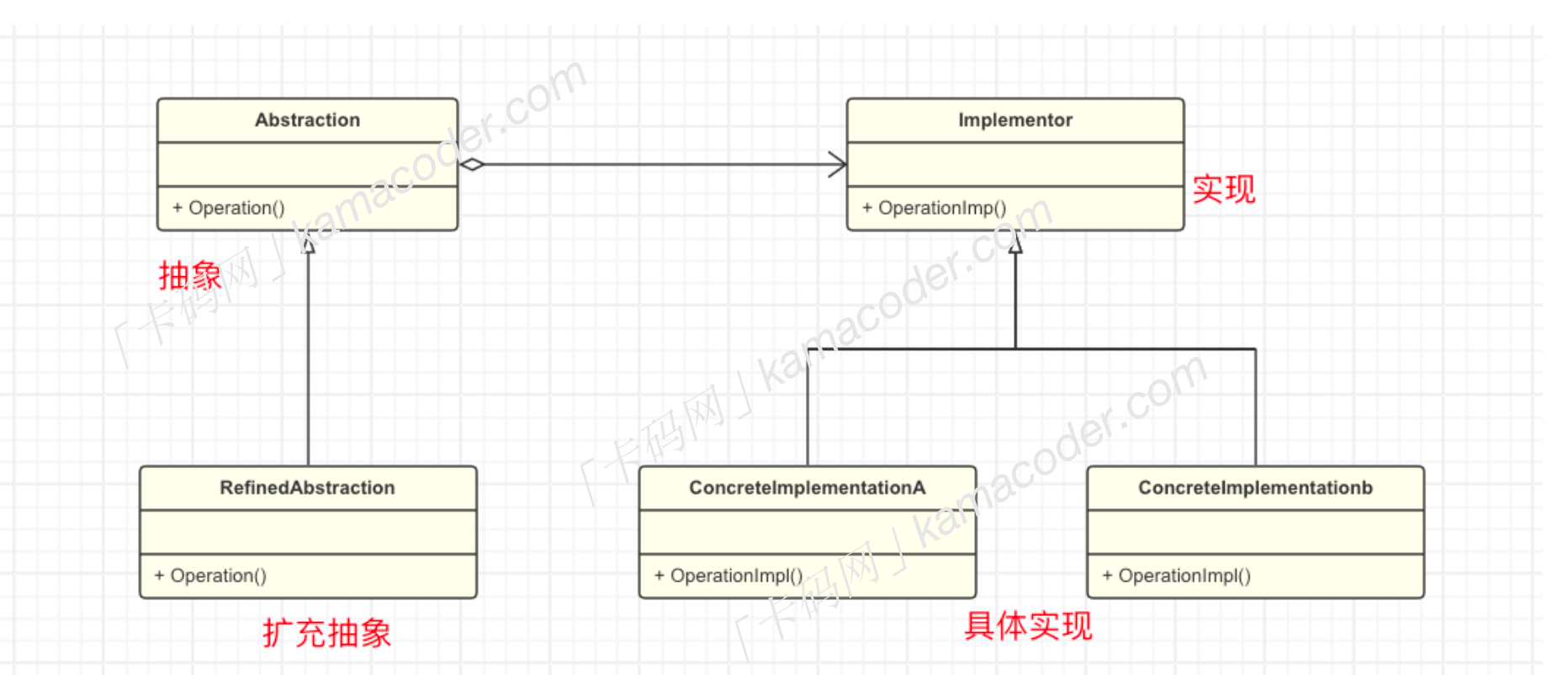10.桥接模式
桥接模式是一种结构型设计模式,它的UML图很像一座桥,它通过将【抽象部分】与【实现部分】分离,使它们可以独立变化,从而达到降低系统耦合度的目的。
需求
【设计模式专题之桥接模式】10-万能遥控器
**题目描述
- 小明家有一个万能遥控器,能够支持多个品牌的电视。每个电视可以执行开机、关机和切换频道的操作,请你使用桥接模式模拟这个操作。
**输入描述
- 第一行是一个整数 N(1 <= N <= 100),表示后面有 N 行输入。
- 接下来的 N 行,每行包含两个数字。第一个数字表示创建某个品牌的遥控和电视,第二个数字表示执行的操作。
- 其中,0 表示创建 Sony 品牌的电视,1 表示创建 TCL 品牌的遥控和电视;
- 2 表示开启电视、3表示关闭电视,4表示切换频道。
输入示例
6
0 2
1 2
0 4
0 3
1 4
1 3
输出示例
Sony TV is ON
TCL TV is ON
Switching Sony TV channel
Sony TV is OFF
Switching TCL TV channel
TCL TV is OFF
基本概念
桥接模式(Bridge Pattern)是一种结构型设计模式,它的UML图很像一座桥,它通过将【抽象部分】与【实现部分】分离,使它们可以独立变化,从而达到降低系统耦合度的目的。桥接模式的主要目的是通过组合建立两个类之间的联系,而不是继承的方式。
举个简单的例子,图形编辑器中,每一种图形都需要蓝色、红色、黄色不同的颜色,如果不使用桥接模式,可能需要为每一种图形类型和每一种颜色都创建一个具体的子类,而使用桥接模式可以将图形和颜色两个维度分离,两个维度都可以独立进行变化和扩展,如果要新增其他颜色,只需添加新的 Color 子类,不影响图形类;反之亦然。

基本结构
桥接模式的基本结构分为以下几个角色:
- 抽象
Abstraction:一般是抽象类,定义抽象部分的接口,维护一个对【实现】的引用。 - 修正抽象
RefinedAbstaction:对抽象接口进行扩展,通常对抽象化的不同维度进行变化或定制。 - 实现
Implementor: 定义实现部分的接口,提供具体的实现。这个接口通常是抽象化接口的实现。 - 具体实现
ConcreteImplementor:实现实现化接口的具体类。这些类负责实现实现化接口定义的具体操作。

再举个例子,遥控器就是抽象接口,它具有开关电视的功能,修正抽象就是遥控器的实例,对遥控器的功能进行实现和扩展,而电视就是实现接口,具体品牌的电视机是具体实现,遥控器中包含一个对电视接口的引用,通过这种方式,遥控器和电视的实现被分离,我们可以创建多个遥控器,每个遥控器控制一个品牌的电视机,它们之间独立操作,不受电视品牌的影响,可以独立变化。
简易实现
下面是实现桥接模式的基本步骤:
- 创建实现接口
interface Implementation {
void operationImpl();
}
以电视举例, 具有开关和切换频道的功能。
interface TV {
void on();
void off();
void tuneChannel();
}
- 创建具体实现类:实际提供服务的对象。
class ConcreteImplementationA implements Implementation {
@Override
public void operationImpl() {
// 具体实现A
}
}
class ConcreteImplementationB implements Implementation {
@Override
public void operationImpl() {
// 具体实现B
}
}
以电视举例,创建具体实现类
class ATV implements TV {
@Override
public void on() {
System.out.println("A TV is ON");
}
@Override
public void off() {
System.out.println("A TV is OFF");
}
@Override
public void tuneChannel() {
System.out.println("Tuning A TV channel");
}
}
class BTV implements TV {
@Override
public void on() {
System.out.println("B TV is ON");
}
@Override
public void off() {
System.out.println("B TV is OFF");
}
@Override
public void tuneChannel() {
System.out.println("Tuning B TV channel");
}
}
- 创建抽象接口:包含一个对实现化接口的引用。
public abstract class Abstraction {
protected IImplementor mImplementor;
public Abstraction(IImplementor implementor) {
this.mImplementor = implementor;
}
public void operation() {
this.mImplementor.operationImpl();
}
}
abstract class RemoteControl {
// 持有一个实现化接口的引用
protected TV tv;
public RemoteControl(TV tv) {
this.tv = tv;
}
abstract void turnOn();
abstract void turnOff();
abstract void changeChannel();
}
- 实现抽象接口,创建
RefinedAbstaction类
class RefinedAbstraction implements Abstraction {
private Implementation implementation;
public RefinedAbstraction(Implementation implementation) {
this.implementation = implementation;
}
@Override
public void operation() {
// 委托给实现部分的具体类
implementation.operationImpl();
}
}
class BasicRemoteControl extends RemoteControl {
public BasicRemoteControl(TV tv) {
super(tv);
}
@Override
void turnOn() {
tv.on();
}
@Override
void turnOff() {
tv.off();
}
@Override
void changeChannel() {
tv.tuneChannel();
}
}
- 客户端使用
// 客户端代码
public class Main {
public static void main(String[] args) {
// 创建具体实现化对象
Implementation implementationA = new ConcreteImplementationA();
Implementation implementationB = new ConcreteImplementationB();
// 使用扩充抽象化对象,将实现化对象传递进去
Abstraction abstractionA = new RefinedAbstraction(implementationA);
Abstraction abstractionB = new RefinedAbstraction(implementationB);
// 调用抽象化的操作
abstractionA.operation();
abstractionB.operation();
}
}
public class Main {
public static void main(String[] args) {
TV aTV = new ATV();
TV bTV = new BTV();
RemoteControl basicRemoteForA = new BasicRemoteControl(aTV);
RemoteControl basicRemoteForB = new BasicRemoteControl(bTV);
basicRemoteForA.turnOn(); // A TV is ON
basicRemoteForA.changeChannel(); // Tuning A TV channel
basicRemoteForA.turnOff(); // A TV is OFF
basicRemoteForB.turnOn(); // B TV is ON
basicRemoteForB.changeChannel(); // Tuning B TV channel
basicRemoteForB.turnOff(); // B TV is OFF
}
}
使用场景
桥接模式在日常开发中使用的并不是特别多,通常在以下情况下使用:
-
当一个类存在两个独立变化的维度,而且这两个维度都需要进行扩展时,使用桥接模式可以使它们独立变化,减少耦合。
-
不希望使用继承,或继承导致类爆炸性增长
总体而言,桥接模式适用于那些有多个独立变化维度、需要灵活扩展的系统。
本题代码
import java.util.Scanner;
// 步骤1: 创建实现化接口
interface TV {
void turnOn();
void turnOff();
void switchChannel();
}
// 步骤2: 创建具体实现化类
class SonyTV implements TV {
@Override
public void turnOn() {
System.out.println("Sony TV is ON");
}
@Override
public void turnOff() {
System.out.println("Sony TV is OFF");
}
@Override
public void switchChannel() {
System.out.println("Switching Sony TV channel");
}
}
class TCLTV implements TV {
@Override
public void turnOn() {
System.out.println("TCL TV is ON");
}
@Override
public void turnOff() {
System.out.println("TCL TV is OFF");
}
@Override
public void switchChannel() {
System.out.println("Switching TCL TV channel");
}
}
// 步骤3: 创建抽象化接口
abstract class RemoteControl {
protected TV tv;
public RemoteControl(TV tv) {
this.tv = tv;
}
abstract void performOperation();
}
// 步骤4: 创建扩充抽象化类
class PowerOperation extends RemoteControl {
public PowerOperation(TV tv) {
super(tv);
}
@Override
void performOperation() {
tv.turnOn();
}
}
class OffOperation extends RemoteControl {
public OffOperation(TV tv) {
super(tv);
}
@Override
void performOperation() {
tv.turnOff();
}
}
class ChannelSwitchOperation extends RemoteControl {
public ChannelSwitchOperation(TV tv) {
super(tv);
}
@Override
void performOperation() {
tv.switchChannel();
}
}
// 步骤5: 客户端代码
public class Main {
public static void main(String[] args) {
Scanner scanner = new Scanner(System.in);
int N = scanner.nextInt();
scanner.nextLine();
for (int i = 0; i < N; i++) {
String[] input = scanner.nextLine().split(" ");
int brand = Integer.parseInt(input[0]);
int operation = Integer.parseInt(input[1]);
TV tv;
if (brand == 0) {
tv = new SonyTV();
} else {
tv = new TCLTV();
}
RemoteControl remoteControl;
if (operation == 2) {
remoteControl = new PowerOperation(tv);
} else if (operation == 3) {
remoteControl = new OffOperation(tv);
} else {
remoteControl = new ChannelSwitchOperation(tv);
}
remoteControl.performOperation();
}
scanner.close();
}
}
其他语言版本
C++
#include <iostream>
#include <sstream>
#include <vector>
// 步骤1: 创建实现化接口
class TV {
public:
virtual void turnOn() = 0;
virtual void turnOff() = 0;
virtual void switchChannel() = 0;
};
// 步骤2: 创建具体实现化类
class SonyTV : public TV {
public:
void turnOn() override {
std::cout << "Sony TV is ON" << std::endl;
}
void turnOff() override {
std::cout << "Sony TV is OFF" << std::endl;
}
void switchChannel() override {
std::cout << "Switching Sony TV channel" << std::endl;
}
};
class TCLTV : public TV {
public:
void turnOn() override {
std::cout << "TCL TV is ON" << std::endl;
}
void turnOff() override {
std::cout << "TCL TV is OFF" << std::endl;
}
void switchChannel() override {
std::cout << "Switching TCL TV channel" << std::endl;
}
};
// 步骤3: 创建抽象化接口
class RemoteControl {
protected:
TV* tv;
public:
RemoteControl(TV* tv) : tv(tv) {}
virtual void performOperation() = 0;
};
// 步骤4: 创建扩充抽象化类
class PowerOperation : public RemoteControl {
public:
PowerOperation(TV* tv) : RemoteControl(tv) {}
void performOperation() override {
tv->turnOn();
}
};
class OffOperation : public RemoteControl {
public:
OffOperation(TV* tv) : RemoteControl(tv) {}
void performOperation() override {
tv->turnOff();
}
};
class ChannelSwitchOperation : public RemoteControl {
public:
ChannelSwitchOperation(TV* tv) : RemoteControl(tv) {}
void performOperation() override {
tv->switchChannel();
}
};
// 步骤5: 客户端代码
int main() {
int N;
std::cin >> N;
std::cin.ignore();
for (int i = 0; i < N; i++) {
std::string input;
std::getline(std::cin, input);
std::istringstream iss(input);
int brand, operation;
iss >> brand >> operation;
TV* tv;
if (brand == 0) {
tv = new SonyTV();
} else {
tv = new TCLTV();
}
RemoteControl* remoteControl;
if (operation == 2) {
remoteControl = new PowerOperation(tv);
} else if (operation == 3) {
remoteControl = new OffOperation(tv);
} else {
remoteControl = new ChannelSwitchOperation(tv);
}
remoteControl->performOperation();
delete tv;
delete remoteControl;
}
return 0;
}
Python
# 步骤1: 创建实现化接口
class TV:
def turn_on(self):
pass
def turn_off(self):
pass
def switch_channel(self):
pass
# 步骤2: 创建具体实现化类
class SonyTV(TV):
def turn_on(self):
print("Sony TV is ON")
def turn_off(self):
print("Sony TV is OFF")
def switch_channel(self):
print("Switching Sony TV channel")
class TCLTV(TV):
def turn_on(self):
print("TCL TV is ON")
def turn_off(self):
print("TCL TV is OFF")
def switch_channel(self):
print("Switching TCL TV channel")
# 步骤3: 创建抽象化接口
class RemoteControl:
def __init__(self, tv):
self.tv = tv
def perform_operation(self):
pass
# 步骤4: 创建扩充抽象化类
class PowerOperation(RemoteControl):
def perform_operation(self):
self.tv.turn_on()
class OffOperation(RemoteControl):
def perform_operation(self):
self.tv.turn_off()
class ChannelSwitchOperation(RemoteControl):
def perform_operation(self):
self.tv.switch_channel()
# 步骤5: 客户端代码
if __name__ == "__main__":
N = int(input())
for _ in range(N):
input_data = input().split(" ")
brand = int(input_data[0])
operation = int(input_data[1])
if brand == 0:
tv = SonyTV()
else:
tv = TCLTV()
if operation == 2:
remote_control = PowerOperation(tv)
elif operation == 3:
remote_control = OffOperation(tv)
else:
remote_control = ChannelSwitchOperation(tv)
remote_control.perform_operation()
Go
package main
import "fmt"
// 步骤1: 创建实现化接口
type TV interface {
TurnOn()
TurnOff()
SwitchChannel()
}
// 步骤2: 创建具体实现化类
type SonyTV struct{}
func (st *SonyTV) TurnOn() {
fmt.Println("Sony TV is ON")
}
func (st *SonyTV) TurnOff() {
fmt.Println("Sony TV is OFF")
}
func (st *SonyTV) SwitchChannel() {
fmt.Println("Switching Sony TV channel")
}
type TCLTV struct{}
func (tt *TCLTV) TurnOn() {
fmt.Println("TCL TV is ON")
}
func (tt *TCLTV) TurnOff() {
fmt.Println("TCL TV is OFF")
}
func (tt *TCLTV) SwitchChannel() {
fmt.Println("Switching TCL TV channel")
}
// 步骤3: 创建抽象化接口
type RemoteControl interface {
PerformOperation()
}
// 步骤4: 创建扩充抽象化类
type PowerOperation struct {
tv TV
}
func (po *PowerOperation) PerformOperation() {
po.tv.TurnOn()
}
type OffOperation struct {
tv TV
}
func (oo *OffOperation) PerformOperation() {
oo.tv.TurnOff()
}
type ChannelSwitchOperation struct {
tv TV
}
func (cso *ChannelSwitchOperation) PerformOperation() {
cso.tv.SwitchChannel()
}
// 步骤5: 客户端代码
func main() {
var N int
fmt.Scan(&N)
for i := 0; i < N; i++ {
var brand, operation int
fmt.Scan(&brand, &operation)
var tv TV
if brand == 0 {
tv = &SonyTV{}
} else {
tv = &TCLTV{}
}
var remoteControl RemoteControl
switch operation {
case 2:
remoteControl = &PowerOperation{tv: tv}
case 3:
remoteControl = &OffOperation{tv: tv}
case 4:
remoteControl = &ChannelSwitchOperation{tv: tv}
}
remoteControl.PerformOperation()
}
}